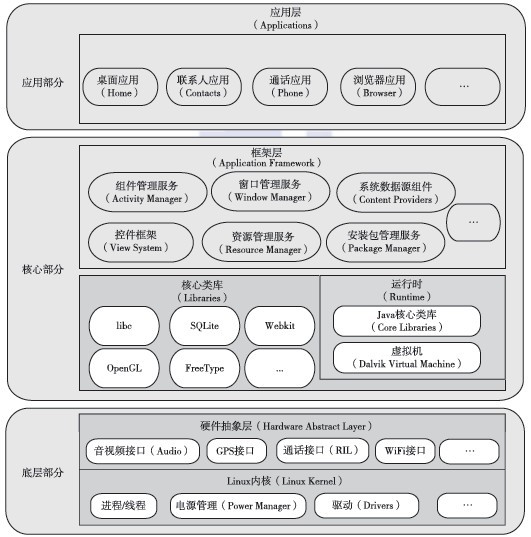
hal体系结构与设计思想
发布日期:2021-06-28 20:33:41
浏览次数:2
分类:技术文章
本文共 4632 字,大约阅读时间需要 15 分钟。
hal体系结构与设计思想
hal在Android 架构中的位置

HAL设计思想
- 为什么需要HAL
- 传统的linux对硬件的操作基本上在内核空间的linux驱动程序中实现了,那么现在为什么那么多此一举把对硬件的操作分为两部分,hal和linux驱动呢? 谷歌搭好了hal的框架,为上层framework打通过jni调用hal提供了统一的api,硬件开发商或者移植人员只需要按照框架开发即可,无需话费精力在与上层的交互上的实现上,将精力放在hal层本身的实现上即可。
- 从商业角度,许多硬件厂商不愿意将自己硬件相关一些核心的东西开源出去,假如将对自己硬件的驱动程序全部放入内核空间驱动程序实现,那么必须遵循GPL协议,是必需开源的。有了HAL层之后,他们可以把一些核心的算法之类的东西的实现放在HAL层,而hal层位于用户空间, 不属于linux内核,和android源码一样遵循的是 appache协议,这个是可以开源或者不开的。
- HAL的实现思路
- 半针对每种硬件实现HAL接口代码,上层应用通过动态库加载的方式,调用HAL层接口代码,实现与硬件通讯功能
- 半伸用C语言的结构体继承的技巧,来实现面向对象语言中继承的概念。
hal实现的方法
- 代码主要路径
/hardware/libhardware/include/hardware/hardware.h//hardware/libhardware/hardware.c
-
关键的数据变量和结构体
struct hw_module_t
typedef struct hw_module_t { /** tag must be initialized to HARDWARE_MODULE_TAG */ uint32_t tag; /** * The API version of the implemented module. The module owner is * responsible for updating the version when a module interface has * changed. * * The derived modules such as gralloc and audio own and manage this field. * The module user must interpret the version field to decide whether or * not to inter-operate with the supplied module implementation. * For example, SurfaceFlinger is responsible for making sure that * it knows how to manage different versions of the gralloc-module API, * and AudioFlinger must know how to do the same for audio-module API. * * The module API version should include a major and a minor component. * For example, version 1.0 could be represented as 0x0100. This format * implies that versions 0x0100-0x01ff are all API-compatible. * * In the future, libhardware will expose a hw_get_module_version() * (or equivalent) function that will take minimum/maximum supported * versions as arguments and would be able to reject modules with * versions outside of the supplied range. */ uint16_t module_api_version;#define version_major module_api_version /** * version_major/version_minor defines are supplied here for temporary * source code compatibility. They will be removed in the next version. * ALL clients must convert to the new version format. */ /** * The API version of the HAL module interface. This is meant to * version the hw_module_t, hw_module_methods_t, and hw_device_t * structures and definitions. * * The HAL interface owns this field. Module users/implementations * must NOT rely on this value for version information. * * Presently, 0 is the only valid value. */ uint16_t hal_api_version;#define version_minor hal_api_version /** Identifier of module */ const char *id; /** Name of this module */ const char *name; /** Author/owner/implementor of the module */ const char *author; /** Modules methods */ struct hw_module_methods_t* methods; /** module's dso */ void* dso;#ifdef __LP64__ uint64_t reserved[32-7];#else /** padding to 128 bytes, reserved for future use */ uint32_t reserved[32-7];#endif} 主要属性:
char* id struct hw_module_methods_tchar* name
-
关键的结构体
struct hw_module_methods_t
typedef struct hw_module_methods_t { /** Open a specific device */ int (*open)(const struct hw_module_t* module, const char* id, struct hw_device_t** device);} 主要属性:
int (*open) (const struct hw_module_t* module , const char* id, struct hw_device_t** device);
-
关键的结构体
struct hw_device_t
typedef struct hw_device_t { /** tag must be initialized to HARDWARE_DEVICE_TAG */ uint32_t tag; /** * Version of the module-specific device API. This value is used by * the derived-module user to manage different device implementations. * * The module user is responsible for checking the module_api_version * and device version fields to ensure that the user is capable of * communicating with the specific module implementation. * * One module can support multiple devices with different versions. This * can be useful when a device interface changes in an incompatible way * but it is still necessary to support older implementations at the same * time. One such example is the Camera 2.0 API. * * This field is interpreted by the module user and is ignored by the * HAL interface itself. */ uint32_t version; /** reference to the module this device belongs to */ struct hw_module_t* module; /** padding reserved for future use */#ifdef __LP64__ uint64_t reserved[12];#else uint32_t reserved[12];#endif /** Close this device */ int (*close)(struct hw_device_t* device);} 主要属性:
int (*close)(struct hw_device_t* device);
hal模块的实现方法

获取,释放Module和Device结构对象的方法

转载地址:https://blog.csdn.net/yangbinbingA/article/details/117673572 如侵犯您的版权,请留言回复原文章的地址,我们会给您删除此文章,给您带来不便请您谅解!
发表评论
最新留言
逛到本站,mark一下
[***.202.152.39]2024年04月10日 21时37分52秒
关于作者

喝酒易醉,品茶养心,人生如梦,品茶悟道,何以解忧?唯有杜康!
-- 愿君每日到此一游!
推荐文章
Linux运维工程师初级面试题
2019-04-29
GA入门
2019-04-29
kettle问题合集
2019-04-29
spark学习笔记
2019-04-29
Tableau学习笔记
2019-04-29
Kettle学习笔记
2019-04-29
airflow问题合集
2019-04-29
sql
2019-04-29
BI分析
2019-04-29
springboot+mybatis+sharding-jdbc整合分库分表实战
2019-04-29
linux查看文件命令介绍
2019-04-29
Spring bean作用域介绍
2019-04-29
Spring 组件开发利器Aware接口
2019-04-29
Spring bean初始化方法的几种写法
2019-04-29
Spring @Autowired注解使用总结
2019-04-29
Spring bean的生命周期总结
2019-04-29
location.protocol的作用vue-uniapp
2019-04-29
PHP入门学习(一)
2019-04-29
【React系列】输出hello word
2019-04-29